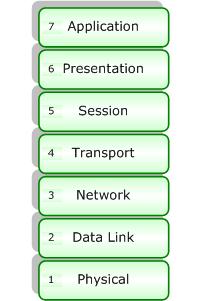| |
|
|
|
|
| |
|
OSI Model |
|
|
|
The early development of networks was disorganized in
many ways. The early 1980s saw tremendous increases in
the number and size of networks. As companies realized
the advantages of using networking technology, networks
were added or expanded almost as rapidly as new network
technologies were introduced.
By the mid-1980s, these companies began to experience
problems from the rapid expansion. Just as people who do
not speak the same language have difficulty
communicating with each other, it was difficult for
networks that used different specifications and
implementations to exchange information. The same
problem occurred with the companies that developed
private or proprietary networking technologies.
Proprietary means that one or a small group of companies
controls all usage of the technology. Networking
technologies strictly following proprietary rules could
not communicate with technologies that followed
different proprietary rules.
To address the problem of network incompatibility, the
International Organization for Standardization (ISO)
researched networking models like Digital Equipment
Corporation net (DECnet), Systems Network Architecture (SNA),
and TCP/IP in order to find a generally applicable set
of rules for all networks. Using this research, the ISO
created a network model that helps vendors create
networks that are compatible with other networks.
The Open System Interconnection (OSI) reference model
released in 1984 was the descriptive network model that
the ISO created. It provided vendors with a set of
standards that ensured greater compatibility and
interoperability among various network technologies
produced by companies around the world.
The OSI reference model has become the primary model for
network communications. Although there are other models
in existence, most network vendors relate their products
to the OSI reference model. This is especially true when
they want to educate users on the use of their products.
It is considered the best tool available for teaching
people about sending and receiving data on a network. |
| |
|
 |
| |
|
The OSI reference model is a framework that is used to
understand how information travels throughout a network.
The OSI reference model explains how packets travel
through the various layers to another device on a
network, even if the sender and destination have
different types of network media.
In the OSI reference model, there are seven numbered
layers, each of which illustrates a particular network
function. Dividing the network into seven layers
provides the following advantages:
• It breaks network communication into smaller, more
manageable parts.
• It standardizes network components to allow multiple
vendor development and support.
• It allows different types of network hardware and
software to communicate with each other.
• It prevents changes in one layer from affecting other
layers.
• It divides network communication into smaller parts to
make learning it easier to understand.
In the OSI Model each layer has specific functions. Each
layer processes its data and passes it on to its
adjacent layer. The Functions are listed below
1. Physical Layer:
The physical layer handles the bits, connectors,
voltages and data rates i.e. it deals with the physical
medium like a coaxial cable and sends the data in forms
of 0s and 1s.
2. Data Link Layer :
It is responsible for reliable data transfer of data
through the media. This layer understands the physical
address(Media Access Control Address) of the network
device and helps in flow control and error correction
during data transfer.
3. Network Layer: This layer provides reliable data
transfer. It deals with the logical address or the
IP(Internet Protocol) Address.
4. Transport Layer: This layer is responsible for the
transportation issues between hosts. This layer is
responsible for fault detection and recovery of flow
control.
5. Session Layer: This layer is responsible for
establishing and terminating virtual circuits for data
transfer between two network devices.
6. Presentation layer: This layer is responsible for
decrypting the data and formats the data as sent by the
sender. It also negotiates data transfer syntax for the
Application layer above it.
7. Application Layer: This layer provides network
services to the applications like email, File Transfer
Protocol or remote monitoring of device. |
| |
|
|
|
|


